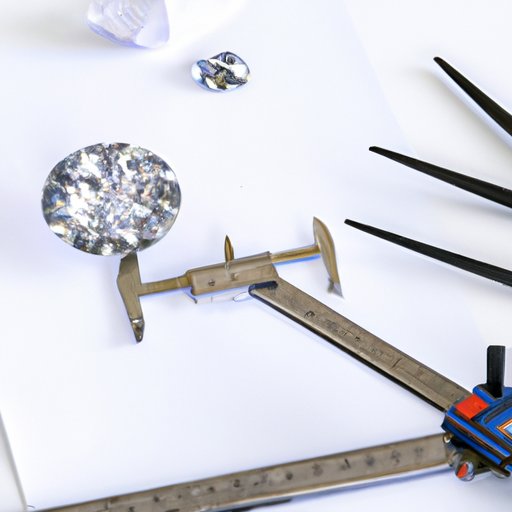Introduction
Have you ever stumbled upon a rock or gemstone that you think might be a diamond? Or maybe you’re in the market for a raw diamond and want to know how to identify one. Well, you’re in the right place! In this article, we’ll guide you through the physical characteristics of raw diamonds, the tools used by experts to identify them, and a step-by-step guide to identifying raw diamonds. We’ll also cover some common misconceptions about raw diamonds and provide tips on how to avoid damaging them.
Physical Characteristics of Raw Diamonds
Raw diamonds come in all shapes, sizes, and colors. The color of a diamond can range from colorless to yellow, brown, or even black. However, most diamonds have a slight yellow or brown hue. When it comes to shape, raw diamonds can be dodecahedron, octahedron, or cuboctahedron. The crystalline structure of a diamond is one of the most important characteristics to look for while identifying raw diamonds. Diamond crystals have a unique cubic structure, which means they appear as symmetrical, three-dimensional shapes made up of equilateral triangles. Raw diamonds can also have surface characteristics like indentations, cavities, and irregularities.
To identify a raw diamond, try looking for some of these physical characteristics. For example, if a stone is colorless and has a cubic structure, there is a high possibility that it is a diamond. Similarly, if the stone appears to have a glass-like luster, it might be a diamond.
Tools Required to Identify Raw Diamonds
While visual cues are essential in identifying raw diamonds, experts and gemologists rely heavily on tools to identify them accurately. Here are a few tools used in identifying raw diamonds:
- Diamond Microscope: A specialized gemological microscope can magnify the diamond up to 100x, providing a closer look at the surface characteristics and inclusions.
- Diamond Tester: A diamond tester is a portable device that helps in determining whether a gemstone is a diamond or not by measuring its thermal conductivity.
- Loupe: A magnifying glass with a 10x magnification that helps in identifying inclusions, and surface characteristics of gemstones.
- UV Light: UV light is used to identify the fluorescence of a diamond. Most diamonds fluoresce blue under UV light, but some may also fluoresce different colors.
Step-by-Step Guide to Identifying Raw Diamonds
Follow these steps to identify whether a diamond is raw or not:
- The first step is to examine the diamond visually. Look for colorless or off-white stones with a crystalline structure.
- Inspect the diamond closely under a microscope or a loupe to check for any surface characteristics such as blemishes, scratches, or marks.
- Use a diamond tester to determine whether the stone is a diamond or not.
- Turn off the lights and use UV light to see if the diamond fluoresces or not.
- Take note of all the results and characteristics you have observed and use them to cross-check with online databases to learn more about the diamond.
The Importance of Professional Assistance
While it’s possible to identify raw diamonds by yourself, it’s always advisable to seek professional assistance. Gemologists and diamond experts have years of experience and knowledge that enable them to identify diamonds more substantively, and with precision. Experts have access to specialized equipment and databases that can help in identifying and verifying diamonds. They can also give you a much more accurate appraisal of your diamond’s value.
If you decide to go for a consultation, ensure you find a reputable professional to avoid being misled. You can ask for referrals from friends or family, read online reviews, and confirm their certification and experience.
Procedures to Avoid that Might Damage Raw Diamonds
To prevent damaging your raw diamonds while identifying them, it’s essential to handle them with care. Here are some tips:
- Avoid touching the diamond: Skin oils and residue can damage the diamond’s surface. Use gloves or tweezers to handle the diamond.
- Secure the diamond: Always ensure the diamond is secure while handling it to prevent it from falling and cracking.
- Avoid testing diamonds on your teeth: Despite what many people believe, using your teeth to test whether a diamond is real can cause damage to the diamond.
Common Misconceptions About Raw Diamonds
There are several misunderstandings about raw diamonds that many people believe. Here are two of the most common misconceptions:
- Myth 1: All raw diamonds are colorless.
- Reality: Raw diamonds can come in a range of colors, including red, pink, blue, green, and yellow.
- Myth 2: Only diamond experts can identify a raw diamond.
- Reality: While it may be easier for diamond experts to identify raw diamonds, anyone can learn to identify them with the right knowledge and tools.
Conclusion
Identifying raw diamonds can be an exciting process, and with the right knowledge and tools, you can confidently identify them. Remember to always handle raw diamonds with care and seek professional assistance if you have any doubts. Keep in mind that not all diamonds are colorless and that anyone can learn to identify diamonds, not just experts.
